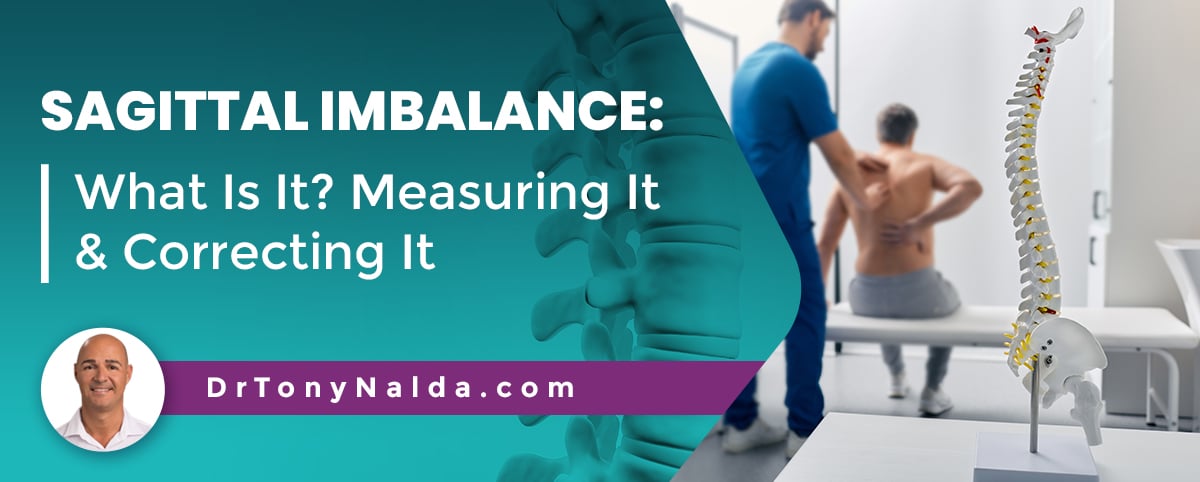Sagittal Imbalance: What Is It? Measuring It & Correcting It

A spine that's balanced is one that's going to be strong, aligned, and functions well, but if a spine is unbalanced, its biomechanics are disrupted, and this can affect its overall health, strength, and function. Measuring the degree of sagittal imbalance determines its severity, and when it comes to treatment plans, they are case-specific and based on important patient/condition variables.
A sagittal imbalance develops when there is a front-to-back imbalance in the spine; measuring it involves what's known as the C-seven plumb line and sagittal vertical axis (SVA), and how to correct it will depend on its underlying cause.
Within the spine's healthy curves, there is a natural range of curvature size, but when an excessive unnatural spinal curve develops, problems can occur; let's start with exploring the spine's natural and healthy curves.
Table of Contents
Natural and Healthy Spinal Curves
When the spine's natural and healthy curves are in place, it's balanced as it should be, and this helps the spine function as it was designed; it allows us to remain upright and practice good posture, move flexibly, absorb and distribute mechanical stress, and works with the brain to form the body's central nervous system (CNS).
The spine has three main sections, and each has a characteristic curvature type: cervical spine (neck), thoracic spine (middle/upper back), and the lumbar spine (lower back).
There are two main front-to-back curvature types known as kyphosis and lordosis.
The spine's natural kyphosis is an outward curve, bending away from the body's center, while the spine's lordotic curves bend inwards, towards the body's center.
The spine's kyphotic curve is found in the thoracic spine (thoracic kyphosis), while the spine's natural lordosis is found in the cervical spine (cervical lordosis) and the lumbar spine (lumbar lordosis).
When the spine's degree of kyphosis and lordosis falls within a healthy range, those curves work together to maintain the spine and body's alignment, which facilitates a typical center of gravity over the pelvis and hips; if one of these curves falls beyond a healthy range, the spine will develop a sagittal imbalance: a-front-to-back imbalance.
A sagittal imbalance introduces uneven forces to the spine, its surrounding muscles and nerves, and the entire body, but there are also different types of sagittal imbalances; let's explore.
Types of Sagittal Imbalance
The spine's sagittal alignment is key to maintaining its optimal strength, health, and function, and different types of sagittal imbalances are determined by their underlying cause.
 Different types of sagittal imbalance can include flatback syndrome, hyperkyphosis, and what's known as chin-on-chest syndrome.
Different types of sagittal imbalance can include flatback syndrome, hyperkyphosis, and what's known as chin-on-chest syndrome.
In flatback syndrome, the lumbar spine has experienced a loss of its healthy lordosis, meaning the lower back's inward curve has become excessively straight, and this pushes the body's center of gravity forward and creates an imbalance.
In some cases, the presence of an underlying spinal condition that involves a loss of healthy spinal curves is behind the development of a sagittal imbalance, such as ankylosing spondylitis, adolescent idiopathic scoliosis, and/or adult scoliosis.
When hyperkyphosis is an issue, the spine's thoracic kyphosis (outward curve) becomes over-pronounced, causing the upper back and shoulders to become excessively rounded forward, causing what's known as a roundback appearance.
Chin-on-chest syndrome is a type of severe kyphosis.
Now that we've defined the condition and explored its different types, let's break down the term sagittal imbalance and explore how it's measured.
How to Measure a Sagittal Imbalance
As we've discussed what the imbalance portion of the term sagittal imbalance means, let's address where the term sagittal comes from.
In the medical world, the body is divided into different anatomical planes: the coronal plane, axial plane, and the sagittal plane.
Dividing the body up in this manner provides a visual accompaniment to how conditions are classified, partially based on the section of the body most affected, and the parts of the body within each section.
If you picture an upright body, imagine there are lines drawn through it to separate sections.
The coronal plane separates the front and back half of the body: a vertical line drawn down the middle half of the body.
The axial plane is represented by a horizontal line that separates the top half of the body from the bottom half, and the sagittal plane is shown by a vertical line through the middle of the body that separates the left half of the body from the right.
Hence the term sagittal imbalance refers to an imbalance in the spine's front-to-back curvature, and assessing alignment is key to determining how severe a person's sagittal imbalance is.
The best way to determine what's happening in and around the spine is through X-ray imaging, and for measuring a patient's sagittal imbalance, I often use an upright scan as this shows the spine in its entirety, in a single image.
Through X-ray imaging, I can assess a patient's sagittal plane alignment, and if more-detailed images of the spine are needed, I can order magnetic resonance imaging (MRI) and/or computed tomography scans, commonly known as a CT scan.
There are different techniques for measuring the degree of sagittal imbalance, but the most common, by far, is what's known as the C7 plumb line and sagittal vertical axis (SVA).
Determining the C7 plumb line and sagittal vertical axis measurement involves drawing a vertical line from the middle of the seventh vertebral body (C7) in the cervical spine (neck), and that line should pass through the the first vertebral body of the sacrum (S1); the sacrum sits between the bones of the hip and pelvis.
If the line passes through the S1, or is within 5 mms, this is considered a normal range of sagittal imbalance; if the line doesn't pass through the S1 vertebra, or isn't within that healthy range, how far beyond that range a person's sagittal imbalance is is measured and expressed in degrees.
So now that we understand spinal sagittal curves and how they are assessed and measured, let's move onto how a sagittal imbalance can be corrected with treatment.
How to Correct a Sagittal Imbalance
Treatment options for correcting a sagittal imbalance will depend on its underlying cause; however, treatment results can never be guaranteed.
Treatment plans have to be customized to address key condition/patient variables, one of which is underlying cause, and others include patient age and overall health, location within the spine, and condition severity.
My goal is to treat a sagittal imbalance without corrective surgery as all types of surgical correction comes with potential risks, side effects, and complications.
 When there is a sagittal imbalance, a noticeable pelvic tilt can develop, and in order to improve a patient's spinopelvic alignment, the condition's uneven forces have to be reduced.
When there is a sagittal imbalance, a noticeable pelvic tilt can develop, and in order to improve a patient's spinopelvic alignment, the condition's uneven forces have to be reduced.
When flatback syndrome is the type of spinal imbalance, this means there is a loss of the lumbar lordosis, so treatment involves restoring the lower back's natural inward curve.
In cases where the presence of an underlying spinal condition, like scoliosis, is the cause, the underlying condition itself has to be the focus of treatment, and as degenerative lumbar scoliosis is associated with a sagittal imbalance, here at the Scoliosis Reduction Center, I can help by working towards reducing the scoliosis on a structural level so the spine is re-aligned and balanced.
My conservative treatment approach involves combining condition-specific chiropractic care, physical therapy, corrective bracing, and rehabilitation.
When hyperkyphosis is the cause of the sagittal alignment issues, the type of kyphosis is important and is the focus of treatment, which, again, involves correcting the unnatural spinal curve so the spine is aligned, balanced, and stable.
Postural kyphosis is the most common and as a non-structural condition, this is the simplest type to treat as it's caused by chronic poor posture, rather than a structural sagittal deformity within the spine itself; this type is commonly treated with lifestyle guidance, postural remodeling (improved patient positioning), and physical therapy.
When Scheuermann's kyphosis is the cause, this is more complex to treat because as a structural condition, there is a structural issue behind the spinal deformity; treatment involves chiropractic care that works towards repositioning the most-tilted vertebrae back into alignment with the rest of the spine, and physical therapy to increase core strength so the spine can be optimally supported by its surrounding muscles.
In cases of congenital kyphosis, these patients are born with the condition due to a malformed spine that develops in utero; as a structural condition, this is also complex to treat, particularly due to patient age.
I can modify treatment plans to address the unique challenges of addressing a sagittal imbalance based on a malformed spine, and this can involve observation, physical therapy, and when appropriate, bracing to help support, stabilize, and correct the spine.
Conclusion
Regardless of the cause of a sagittal imbalance, it needs to be addressed proactively; maintaining a healthy sagittal balance means the body's center of gravity is where it should be and the body isn't being exposed to uneven forces.
The spine is subject to natural age-related spinal degeneration, so spinal conditions that are left untreated tend to get worse over time, particularly as the spine starts to deteriorate with age and spinal balance is disrupted.
A sagittal imbalance that's left unaddressed is going to make the spine more unstable and unbalanced over time, and this doesn't just affect the spine, but also its surrounding muscles and nerves, and as a body's center of gravity shifts, the entire body.
Maintaining spinal alignment is key to optimal spinal health, strength, and function, and having an issue with sagittal spinal alignment means the spine has a front-to-back imbalance.
Some common causes of sagittal alignment issues are hyperkyphosis and/or the presence of other spinal conditions like scoliosis.
Regardless of cause or severity, the best time to start treatment for a sagittal imbalance is always now, before the spine gets increasingly unbalanced and unstable, making it more complex to treat, and before invasive and risky spinal fusion surgery is needed.
Dr. Tony Nalda
DOCTOR OF CHIROPRACTIC
After receiving an undergraduate degree in psychology and his Doctorate of Chiropractic from Life University, Dr. Nalda settled in Celebration, Florida and proceeded to build one of Central Florida’s most successful chiropractic clinics.
His experience with patients suffering from scoliosis, and the confusion and frustration they faced, led him to seek a specialty in scoliosis care. In 2006 he completed his Intensive Care Certification from CLEAR Institute, a leading scoliosis educational and certification center.
About Dr. Tony Nalda
 Ready to explore scoliosis treatment? Contact Us Now
Ready to explore scoliosis treatment? Contact Us Now





